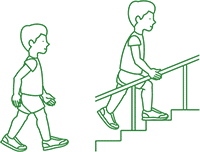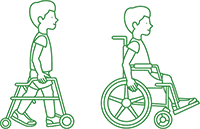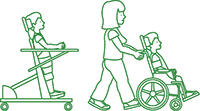The gross motor skills (e.g. sitting and walking) of children and young people with cerebral palsy can be categorised into 5 different levels using a tool called the Gross Motor Function Classification System (GMFCS) developed by CanChild in Canada.
GMFCS looks at movements such as sitting, walking and use of mobility devices. It is helpful because it provides families and clinicians with:
Generally, a child or young person over the age of 5 years will not improve their GMFCS-E&R level so, if for example, a child is classified at a Level IV at the age of 6 then it is likely that they will need to use a mobility device throughout their life.
The CanChild website has full details on GMFCS.
GMFCS is used for infants under 2 years of age through to the 18th birthday. GMFCS is published in several different languages and a Family and Self Report Questionnaire is available.

Children walk at home, school, outdoors and in the community. They can climb stairs without the use of a railing. Children perform gross motor skills such as running and jumping, but speed, balance and coordination are limited.

Children walk in most settings and climb stairs holding onto a railing. They may experience difficulty walking long distances and balancing on uneven terrain, inclines, in crowded areas or confined spaces.
Children may walk with physical assistance, a handheld mobility device or used wheeled mobility over long distances. Children have only minimal ability to perform gross motor skills such as running and jumping.

Children walk using a hand-held mobility device in most indoor settings. They may climb stairs holding onto a railing with supervision or assistance. Children use wheeled mobility when travelling long distances and may self-propel for shorter distances.

Children use methods of mobility that require physical assistance or powered mobility in most settings. They may walk for short distances at home with physical assistance or use powered mobility or a body support walker when positioned. At school, outdoors and in the community children are transported in a manual wheelchair or use powered mobility.

Children are transported in a manual wheelchair in all settings. Children are limited in their ability to maintain antigravity head and trunk postures and control leg and arm movements.
References:
GMFCS descriptors copyright © Palisano et al. (1997) Dev Med Child Neurol 39:214-23 CanChild
Illustrations copyright Version 2 © Bill Reid, Kate Willoughby, Adrienne Harvey and Kerr Graham, The Royal Children’s Hospital Melbourne.